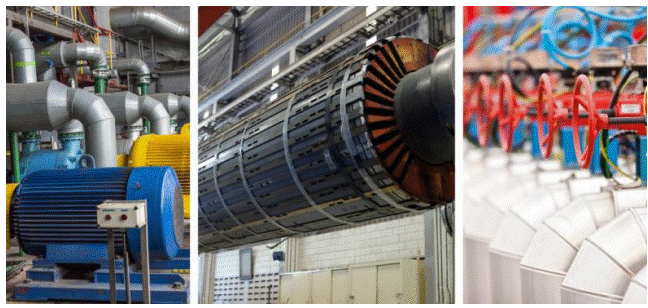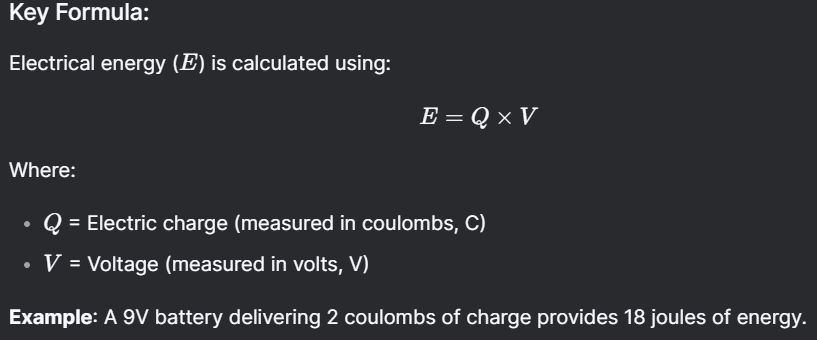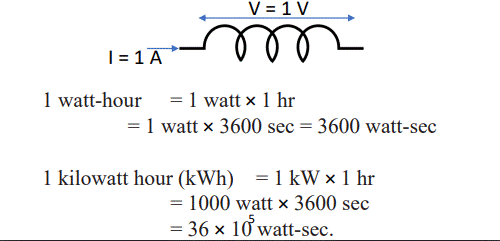



Electrical energy powers our modern world, from lighting homes to fueling industries. But what exactly is it, and how does it shape our daily lives? This guide dives into the science, production, applications, and future of electrical energy, offering clear explanations, real-world examples, and actionable insights.
What Is Electrical Energy?
Electrical energy is the energy derived from the movement of electric charges. It occurs when electrons flow through a conductor, such as a wire, creating an electric current. This energy is secondary, meaning it’s generated by converting primary energy sources like coal, sunlight, or wind.

Understanding Units of Energy: Mechanical, Electrical, and Efficiency
Energy is a fundamental concept in physics and engineering, and understanding its units is key to grasping how it works in everyday applications. Whether you’re dealing with mechanical systems or electrical circuits, energy measurements help quantify work, power, and efficiency. Let’s break down the units of energy and how they relate to real-world scenarios.
Mechanical Energy
Mechanical energy is the energy associated with motion or position. Its unit is the newton-meter (Nm) or joule (J).
- Definition: 1 joule (1 J) is the work done when a force of 1 newton (1 N) moves an object through a distance of 1 meter (1 m).
- Formula:Mechanical Energy (J)=Force (N)×Distance (m)

- Example: Lifting a 1 N weight by 1 meter requires
- 1 N×1 m= 1 Jof energy.

Electrical Energy
Electrical energy is the energy transferred by electric circuits. Its base unit is also the joule (J), but larger units like watt-hours (Wh) or kilowatt-hours (kWh) are commonly used for practicality.
- Definition: 1 joule (1 J) is the energy transferred when 1 ampere (1 A) of current flows through a potential difference of 1 volt (1 V) for 1 second (1 s).
- Formula:Electrical Energy (J)=Voltage (V)×Current (A)×Time (s)


Common Electrical Energy Units
- 1 watt-hour (Wh) = 1 watt × 1 hour = 3600 J
- 3600J (since 1 hour = 3600 seconds).
- 1 kilowatt-hour (kWh) = 1000 watts × 1 hour = 3.6×106 J3.6×106J.
Fun fact: Your electricity bill measures usage in kWh. A 100W bulb running for 10 hours consumes 1 kWh!
Energy Efficiency
No energy conversion is 100% efficient. Energy is often lost as heat, sound, or other forms during processes.

Why These Units Matter
- Mechanical Energy: Helps engineers design systems like elevators or vehicles by calculating work done.
- Electrical Energy: Essential for understanding power consumption, appliance ratings, and reducing electricity costs.
- Efficiency: Critical for sustainability—higher efficiency means less waste and lower energy bills.
Quick Reference Table
| Energy Type | Unit | Equivalent |
|---|---|---|
| Mechanical | Joule (J) | 1 Nm = 1 J |
| Electrical | Watt-hour (Wh) | 1 Wh = 3600 J |
| Electrical | Kilowatt-hour | 1 kWh = 3.6 × 10⁶ J |
Understanding energy units and efficiency empowers you to make smarter decisions, whether you’re building a machine, analyzing your home’s energy use, or advocating for greener technologies. Next time you see a kWh on your electricity bill, remember: it’s not just a number—it’s a measure of work, power, and potential!
Why Is Electrical Energy Important? 10 Key Reasons
1. Powers Modern Civilization
- Electricity runs homes, industries, hospitals, and cities.
- Without it, daily life would halt (no lighting, heating, or communication).
2. Drives Economic Growth
- Industries (manufacturing, IT, agriculture) depend on electrical energy.
- Example: Factories use electric machinery for mass production.
3. Enables Technology & Innovation
- Powers computers, smartphones, AI, and the Internet.
- Critical for research, automation, and smart devices.
4. Improves Healthcare
- Hospitals rely on electricity for:
- Life-saving equipment (ventilators, MRI machines).
- Vaccine refrigeration and sterile environments.
5. Supports Education & Connectivity
- Schools and universities need electricity for:
- Digital learning tools (laptops, projectors).
- Online education platforms.
6. Enhances Transportation
- Electric vehicles (EVs) reduce fossil fuel dependence.
- Public transport (trains, metros) uses electrical energy.
7. Boosts Agricultural Productivity
- Electric irrigation systems, grain dryers, and milking machines.
- Example: Solar-powered water pumps in remote farms.
8. Enables Renewable Energy Transition
- Wind/solar power generate clean electrical energy.
- Reduces greenhouse gas emissions vs. fossil fuels.
9. Essential for Safety & Security
- Street lighting, alarm systems, and emergency services.
- Powers cybersecurity infrastructure (data centers).
10. Improves Quality of Life
- Home appliances (refrigerators, ACs, washing machines).
- Entertainment (TV, gaming, streaming).
How Is Electrical Energy Produced?
Electrical energy generation involves converting other energy forms through various methods:
Fossil Fuel Power Plants
Coal, oil, or natural gas is burned to heat water, producing steam that spins turbines connected to generators.
[Power Plant Process](diagram-placeholder: Combustion → Steam → Turbine → Generator → Electricity)
Renewable Energy Sources
- Solar: Photovoltaic cells convert sunlight directly into electricity.
- Wind: Turbines harness kinetic energy from wind.
- Hydroelectric: Flowing water spins turbines in dams.
Nuclear Energy
Nuclear reactors split atoms (fission), releasing heat to produce steam and drive turbines.
How Do Batteries Store Electrical Energy?
Batteries store energy chemically. When connected to a circuit, a redox reaction releases electrons, generating current.
Examples of Electrical Energy
- Lightning: A natural burst of static electricity (up to 1 billion volts!).
- Household Circuits: Powering lights, TVs, and refrigerators.
- Batteries: Storing energy for devices like smartphones.
- Static Shock: Tiny discharges from friction (e.g., rubbing a balloon).
Is Lightning Electrical Energy?
Yes! Lightning transfers charge between clouds or to the ground, releasing massive electrical energy.
Electrical Energy vs. Other Energy Types
| Energy Type | Source/Form | Conversion Example |
|---|---|---|
| Electrical | Moving electrons | Solar panels → Electricity |
| Thermal (Heat) | Molecular vibration | Toaster converting electricity |
| Kinetic | Motion | Wind turning turbines |
| Chemical | Chemical bonds | Batteries powering devices |
Key Insight: Electrical energy often acts as a “middleman,” converting between other forms (e.g., chemical → electrical → kinetic in electric cars).
Uses of Electrical Energy in Daily Life
- Home Appliances: Lighting, heating, and cooling systems.
- Transportation: Electric vehicles (EVs), trains, and subways.
- Healthcare: MRI machines, ventilators, and surgical tools.
- Industry: Robotics, manufacturing, and data centers.
How Is Electrical Energy Measured?
- Voltage (V): “Pressure” pushing electrons.
- Current (A): Electron flow rate.
- Power (W): Energy per second ((P = V \times I)).
- Kilowatt-hour (kWh): Common unit for billing (1 kWh = 3.6 million joules).
Example Calculation: A 100W bulb running for 10 hours uses:

Advantages and Disadvantages
Pros ✅
- Clean at Point of Use: No direct emissions from devices.
- Highly Controllable: Precise delivery for electronics.
- Versatile: Powers everything from toothbrushes to cities.
Cons ❌
- Production Impacts: Fossil fuels contribute to pollution.
- Storage Challenges: Batteries degrade and have limited capacity.
- Transmission Losses: Energy dissipates over long distances.
Future of Electrical Energy
- Smart Grids: AI-optimized networks reducing waste.
- Energy Storage: Solid-state batteries and hydrogen fuel cells.
- Wireless Transmission: Cutting cords with inductive charging.
- Nuclear Fusion: Mimicking the sun’s energy (if mastered).
FAQs
1. What’s the Difference Between Electrical Energy and Electricity?
Electrical energy refers to the energy carried by moving electrons, while electricity is the broader term for the presence and flow of electric charge. Think of electrical energy as the “work” electricity can do.
2. Can Electrical Energy Be Converted Back to Other Forms?
Yes! For example:
- Electric heaters: Convert electrical → thermal energy.
- Speakers: Convert electrical → sound energy.
- LED lights: Convert electrical → light energy.
3. Why Do Batteries Lose Charge Over Time?
Even when unused, batteries undergo slow chemical reactions (self-discharge) and degrade due to temperature, humidity, or internal resistance.
4. Is Static Electricity the Same as Electrical Energy?
Static electricity is a form of electrical energy caused by an imbalance of charges (e.g., rubbing a balloon on hair). It becomes “current” electricity when charges flow (e.g., a spark).
5. How Does Electrical Energy Travel Through Wires?
Electrons “hop” between atoms in a conductor. The energy transfers at nearly the speed of light, but individual electrons move slowly (drift velocity ≈ 1 mm/s).
6. Why Do Power Lines Use High Voltage?
High voltage reduces energy loss during transmission. Since power (�=�×�P=V×I), increasing voltage allows lower current, minimizing heat dissipation in wires.
7. What Happens to Unused Electrical Energy in a Circuit?
Unused energy is often wasted as heat due to resistance in wires or components (e.g., why devices get warm). Smart grids aim to redirect surplus energy to storage systems.
8. Can We Generate Electrical Energy from Human Activity?
Yes! Piezoelectric materials convert kinetic energy (e.g., footsteps) into electricity. Some sidewalks and dance floors use this tech for low-power applications.
9. What’s the Difference Between AC and DC Electrical Energy?
- AC (Alternating Current): Electrons reverse direction periodically (used in homes).
- DC (Direct Current): Electrons flow one way (used in batteries, solar panels).
10. How Does Electrical Energy Impact the Environment?
Depends on the source:
- Fossil fuels: Emit CO₂ and pollutants.
- Renewables: Minimal emissions but require resource-intensive manufacturing.
11. Why Can’t We Store Large Amounts of Electrical Energy Easily?
Storage systems (e.g., batteries) have limited capacity, degrade over time, and lose energy through heat. Large-scale solutions like pumped hydro exist but are location-dependent.
12. Is Electrical Energy Safe for Humans?
Low-voltage energy (e.g., phone chargers) is safe, but high-voltage currents can disrupt heart rhythms or cause burns. Always follow safety guidelines!
13. How Do Solar Panels Work on Cloudy Days?
They still generate energy from diffuse sunlight but at 10–25% efficiency compared to sunny conditions.
14. What Role Do Transformers Play in Electrical Energy?
Transformers increase (step-up) or decrease (step-down) voltage to optimize energy transmission and distribution.
15. Can Electrical Energy Be Harvested from Radio Waves?
Yes! Emerging tech captures ambient radio waves (e.g., Wi-Fi signals) and converts them into small amounts of usable electricity for low-power devices.
16. How Efficient Are Solar Panels?
Most panels convert 15–22% of sunlight into electricity, with advanced models nearing 30%.
17. Can Electrical Energy Be Renewable?
Yes! When sourced from wind, solar, or hydro systems, it’s fully renewable.
